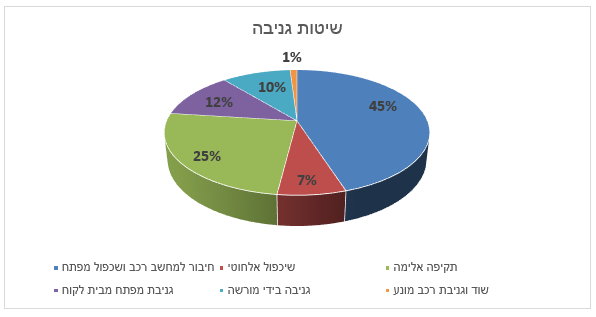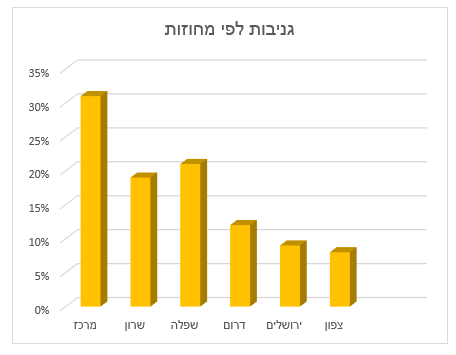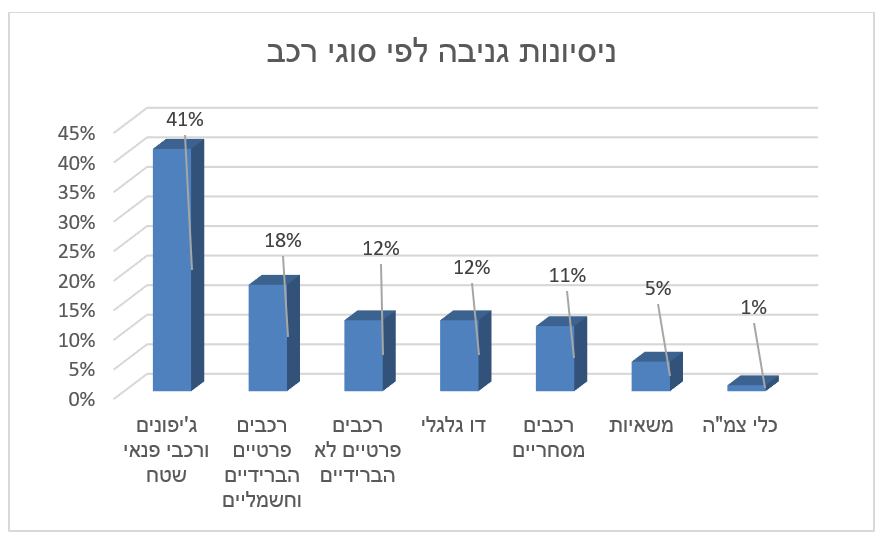The operational lineup of Pointer from Powerfleet Group, the company that locates and recovers stolen vehicles, concludes the nine months of 2023 with car thefts.
- continued growth in car thefts; 162% increase in attempted theft in Q3 2023 compared to Q3 2023
- 115% increase in attempted theft in Q3 2023 compared to Q2 2023.
- For the first time in Israel, car theft attempts from the 2023 model year account for 7% of all attempts compared to the 2.5% known to date.
- A decrease in theft of electric and hybrid vehicles due to technological upgrades adapted to Pointer's electric vehicle models that have been implemented in these vehicles.
- A 33% decrease in thefts in the southern region compared to the previous quarter, alongside a 34% increase in the central region compared to the second quarter of 2023.
- 41% OF THEFT ATTEMPTS ARE SUVS AND SUVS
- continued growth in car thefts; A 162% increase in attempted theft in Q3 2023 compared to Q3 2023.
- The leading cities in car theft: Tel Aviv and Petah Tikva, which jumped 100% together to the previous quarter.
Increase in car theft attempts of 162%:
The third quarter of 2023 ends with a 162% increase in attempted car theft compared to 2022 and a 115% increase compared to the second quarter of 2023. The upward trend of 2022 continues. The thefts are carried out by organized gangs around the clock. Also, for the first time, car theft attempts from the 2023 model year account for 7% of all attempts compared to the 2.5% known to date. The phenomenon is explained by the fact that a large part of the thefts are not carried out for spare parts, but for the purpose of selling the vehicles themselves for personal use in the territories of the Authority.
Top cities in car theft:
A worrying trend is recorded in the two cities of Tel Aviv and Petah Tikva, which jumped by about 100%.
Tel Aviv 11% (compared with 6% in the previous quarter), Petah Tikva 11% (compared with 5.5% in the previous quarter), Jerusalem 7% (compared with 5% in the previous quarter), Netanya 5%, Rishon LeZion, Ramat Gan and Be'er Sheva 4% each. (In Beersheba there was a decrease of 33%)
Thefts by model year:
Vehicles from 2023 account for 7%, vehicles from model year 2022 account for 15% vehicles from model year 2021 account for 24% of all thefts, vehicles from 2020 account for 17% of vehicle thefts, vehicles from model year 2019 account for 13% of all thefts Vehicles from model year 2018 account for 11% of all thefts
Easy crossing at checkpoints:
In addition, after they have managed to infiltrate Israel through breaches in the fence and smuggling illegal aliens through various means, the gangs of car thieves can expect easy passage through checkpoints with a short travel time from the place of theft to checkpoints at the seam line, which do not stop vehicles with yellow license plates especially during daylight hours.
Daylight thefts:
The phenomenon of car theft at all hours of the day is gaining momentum. If in the past most of the attempted thefts were in the wee hours of the night with sparse movement of police and enforcement forces, in the third quarter the thefts are almost evenly distributed throughout the day and there is no fear of thieves' squads. This represents a hundreds of percent increase in daytime theft attempts compared to the same period last year.
Using a mobile disruptor:
IN 88% OF ALL CAR THEFTS, A CELLULAR DISRUPTOR WAS USED TO MASK CELLULAR RECEPTION AND GPS TRANSMISSION. THIS INDICATES ORGANIZED AND SOPHISTICATED GANGS WITH EXPENSIVE ELECTRONIC EQUIPMENT, WHICH ARE SUPPLIED TO THEM BY CRIME FAMILIES, WHO OWN THE CAR DISMANTLING LOTS AT THE TOP OF THE CHAIN AND ARE FINANCED BY THEM.
Ilan Goldstein, CEO of Pointer, describes the process of car theft in Israel: The chain of car theft begins with families who own the dismantling lots, who concentrate the orders for spare parts from the local market and garages in Israel. These issue an order for the requested vehicles according to type, model and sometimes also color. The squads of thieves who are in contact with the car dismantling lot accept the order and go out into the field in search of the right vehicle. Once this is found, the "technologist" in the leading vehicle activates the means of disruption and begins the work of starting the vehicle. At the same time, there is someone from the squad who watches and warns about the approach of people or police forces to the scene. When the vehicle is driven, the driver who is supposed to transport the vehicle enters the liquidation lot. Traveling with the stolen vehicle is often accompanied by reckless driving and dangerous speed, full of traffic violations and even driving contrary to the direction of travel or breaking barriers and spikes. Sometimes the trip is accompanied by collisions and injuries to the body. The lead vehicle usually accompanies the stolen vehicle and warns the driver of police forces and roadblocks.
Popular theft methods:
Cellular disruption – 88% of theft attempts are carried out with a combination of a cellular disruptor alongside the following methods:
- Key duplication: The leading method of theft is still duplication of a "cocoon" key during the theft process, while connecting to an OBD socket through which you connect to the vehicle's computer or using a smart electronic device. The thieves encode a new key and delete the existing keys. About 45% of all recorded theft attempts were based on this method.
- Using a 7% wireless replicator.
- Violent assault: Violent assault of the vehicle by replacing a computer accounted for 25% of all thefts.
- Theft of keys from the customer's home (double): When there is a direct connection between breaking into the customer's home and the vehicle in the adjacent parking lot. accounted for 12% of all thefts recorded this year.
- Authorised theft: Usually carried out by duplication of a key by an authorized user who has received keys and a valid code of the vehicle. This method of theft accounted for 10% of all thefts committed this year.
- Robberies and motor vehicle thefts: accounted for 1% of all thefts this year.

Theft by county nationwide:
In relation to the first quarter of the year, there was a "turnaround" in the areas of theft. The central region is rising significantly relative to the southern region, where a decline is recorded.
Central region – a significant increase of 34% with 31% of all thefts (compared to 23% in the second quarter of the year)
Sharon area – with a decrease of 13% to 19 % of all thefts (compared to 22% in the second quarter of the year)
Southern region – with a significant decline of 33% to 12% (compared to 18% in the second quarter of the year)
Lowland area – a slight decrease in 21% of total thefts (compared to 22% in the second quarter of the year)
Jerusalem and surrounding areas – remained 9% (compared to 9% in the second quarter of the year)
Northern region – up to 8% (compared to 6 % in the second quarter of the year)

Notable times and patterns of theft:
In the third quarter, similar to the second quarter, thefts are committed around the clock, this phenomenon continues to gain momentum and is a continuation of the trend in 2022 and the problem of governance.
Vehicle Theft and Attempted Statistics by Vehicle Type Q3:
- Jeeps and SUVs account for 41% – almost unchanged from the previous quarter.
- Private vehicles, hybrids and electric vehicles – account for 18%. A decrease of 21%.
- Non-hybrid private vehicles account for 12%. An increase of 50%.
- Commercial vehicles account for 11% of all vehicle thefts. An increase of 22%.
- Trucks account for 5% of all car thefts. No change.
- Heavy equipment vehicles account for 1% of all vehicle thefts. Unchanged
- Two-wheelers – account for 12% of all thefts. No change.






